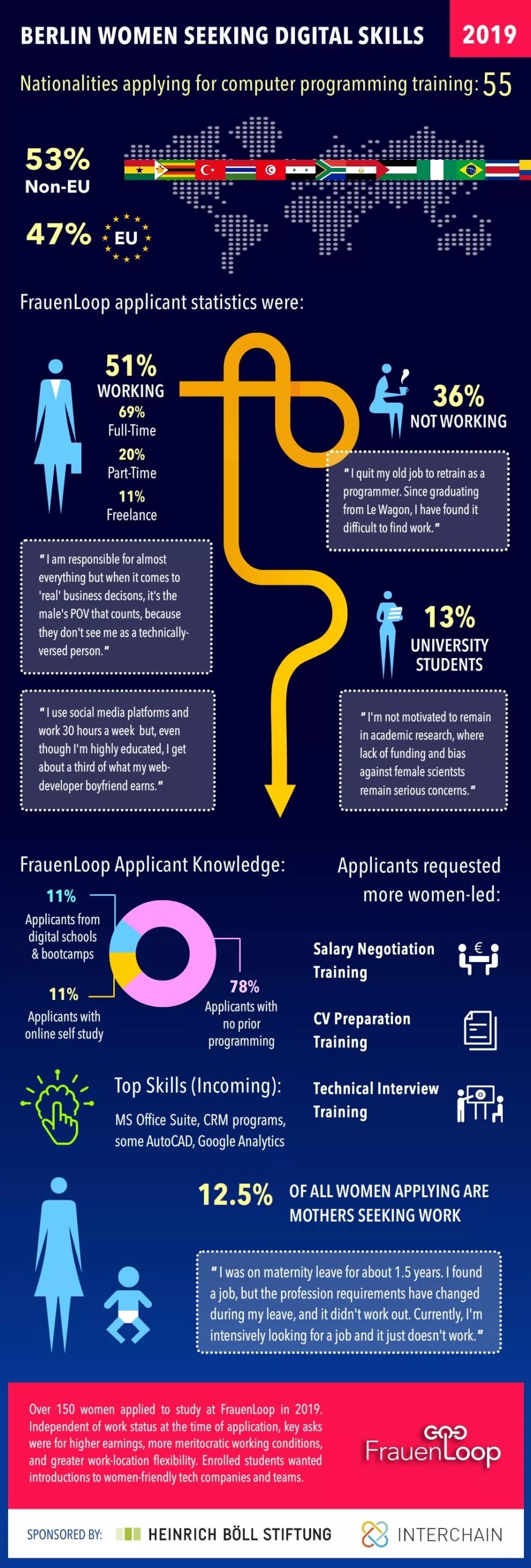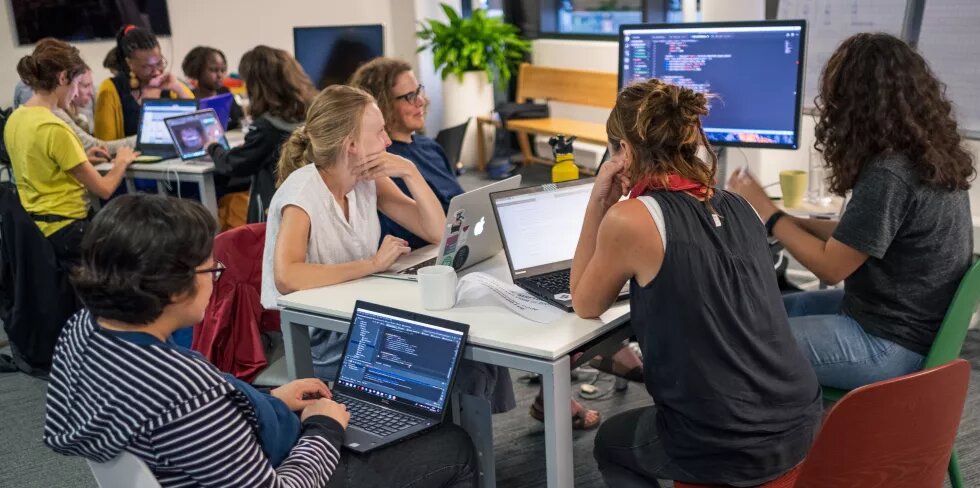
The IT industry is still male-dominated: Only 17 percent of tech startups' employees in Germany are women. What access barriers exist for women of different backgrounds, and how can they be removed? FrauenLoop conducted a study to examine the barriers to education and the labor market for resident, migrant, and refugee women who want to work in the IT industry.

Berlin’s tech startups are booming —but is the picture for women different? Across Germany, 34% of STEM first-year students are women, but women comprise only 17% of IT start-up company employees. In spite of an IT jobs landscape that is over 80% male, many women want to train or to re-train for tech employment. In 2019, almost 4x more women applicants sought computer programming training at FrauenLoop than there were program places available – and applicants included ICT- and STEM-Majors who were completing Masters and PhD studies. The results of this study say a lot about what women from a wide range of backgrounds are looking for and why, when they seek to learn computer programming skills in Berlin.
Background: Many IT jobs, but few for women
In November 2019, BitKom reported a total of approximately 124.000 IT jobs in Germany that were unfilled due to talent shortages. Four years earlier, that figure stood at less than half of this amount (43.000 offeneStellen for IT-Spezialisten) The number of IT jobs has grown exponentially, but the pipeline of talent in Germany has not. Beyond the obvious gap between job-seekers and IT jobs available, there is a marked gender gap in the IT workers who do get hired in Germany. Just 17% percent of IT-sector jobs are held by women, and this number has not changed significantly over the past five years.
Women in Tech
FrauenLoop is a Berlin-based non-profit with gender equity and equal access for resident, refugee and immigrant women to the tech industry as its mission. Since 2016, FrauenLoop has canvassed local shelters, universities, online mothers’ groups and other networks to identify women who are keen to change to careers in tech. This 2019 study was comprised of 152 women applicants between the ages of 21 and 48, of which 53% were from non-EU countries, and 47% were EU citizens. German nationals made up about 26% of the application pool and 6% of all applicants had completed a MINT or ICT university degree.
The FrauenLoop program includes extensive professional training aimed at overcoming the key barriers to women’s tech entry in Germany. Examples of these barriers include womens’
- lack of access to their own portable computer
- lack of confidence due to limited exposure to tech work and to women with computing skills
- lack of access to information about tech hiring processes and tech job listings at start-up companies or in English
- lack of university-level focus on many industry-standard programming languages and tools
- lack of support from local bootcamps and digital training programs alike in effectively preparing to apply for IT roles in industry.
With reference to accessing the tech job market, significant barriers exist for all women, regardless of background.
Discrimination against women in the IT industry
Many of the key obstacles women face throughout the process of seeking IT training and applying to jobs in the tech sector are recorded only in anecdotal form, for instance:
- For women tech applicants in general, it is not uncommon to face questions during the interview process as to whether they have children, whether they plan to have children, and whether any prior breaks in employment are related to their having children. They describe this as a deterrent to applying.
- For mothers who have left the labor force for as little as one year to care for family, it is a challenge to keep their CVs up to date with information that will not lead to discrimination in the hiring process (e.g., mentioning an Elternzeit leave from work or not, to avoid being viewed as less-desirable candidates).
- For women who have immigrated to Germany from other countries, the cultural barrier when applying is significant, even for women applying in English for English-language IT jobs. The CV format that 100% of immigrant and refugee women are instructed to use in government-sponsored German language courses includes superfluous information such as marital status, religion, and secondary school attended. Including this type of information most likely does significant harm to an applicant’s chances to be called for a job interview. Yet a German language class is frequently the only place where immigrant women receive CV-writing instruction.
- For women with refugee status, reaching the interview stage is exceptionally rare, particularly for women who wear religious headgear. As the study by Doris Weichselbaumer in 2016 confirms, inclusion of a photograph on professional CVs in Germany has been proven to support discrimination against Muslim women, in particular, who choose to cover their hair. This obstacle, paired with the migration of many hiring processes to the digital realm, significantly disadvantages refugee women who may lack awareness of the leading digital CV platforms such as Xing, LinkedIn, etc.
- For older women (e.g., those over 35), a lower success rate in winning interviews at all is suspected by many to be related to their age (as demonstrated by photo and length of employment history). However, the automation of many job-application platforms makes it difficult to determine whether this may be a human-bias phenomenon, an algorithmic-bias problem, or merely a problem of a candidate’s under-qualification for a technical role.
- For university students, 100% of even ICT majors at the Master’s level say that they are taught traditional computer programming languages and theory instead of the languages and programming collaboration skills they need for the job market.
Summary
At a minimum, women seeking to build tech skills need tech career orientation delivered by tech professionals who work with software development. Many digital education programs offer social media management, design thinking and digital marketing training to women, without offering computer skills training that are necessary for the better-paid, more stable, and mostly-male IT industry roles. Women are too often confronted with assumptions about being “too old” to learn computing, and this emphasis on targeting “young” talent and “girls” in ICT subjects reinforces the perception of many women that they cannot retrain as tech specialists, because they are “too old” to do so. In this same way, many women are discouraged by the representation of ICT skills by public sector job counselors as something that requires a history of math and science expertise to even attempt to learn.
Women who apply to FrauenLoop after having attended ICT classes at the university level stated that they felt isolated and unsupported in connecting their studies to the local job market: they report that they are typically told to “use YouTube” and that they are expected to learn modern programming languages on their own. Women who apply to FrauenLoop after attending state-subsidized “digital schools” specify tech industry jobs orientation and job placement as areas where they still require help after graduating.
And women who apply to FrauenLoop who have refugee status underline the lack of women instructors in many tech meetup groups and education programs as conditions making those programs less appealing to them. Immigrant women with racial and ethnic-minority backgrounds call attention to a lack of ethnically-/racially-diverse IT instructors and often state that when they see themselves represented in program leadership, they feel more likely to be supported.
How can opportunities for women to enter tech be improved?
Suggestions to attract more women from more diverse backgrounds to tech education and to the tech sector are as follows:
- Broad campaign to change the standard CV format that is taught to immigrant and refugee women in German classes and elsewhere
- Public funding to support tech education programs with diverse and demographically representative instructors and/or leadership
- Public investment into IT industry job sector trainings by diverse tech industry experts with programming experience and IT understanding
- Systematic measurement of women's participation rates (as teachers and learners) and overall effectiveness of publicly-funded digital training programs as a basis for increased funding for the most effective programs
- Broad campaign to abolish the use of photos and other non-essential demographic data from CVs used tech companies and start-ups
This report was first published on Heimatkunde - a platform of the Heinrich-Böll-Foundation.


